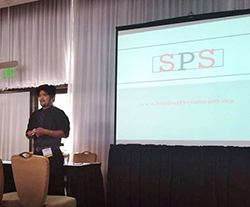His surprising discovery, following Internet searches and consultations with his peers, was that his brainstorm–a student-run news service–didn’t exist.
“I Googled, and saw some wire services geared toward students, but none were actually student-run,” Duario said. “I asked a friend who had been working as a journalist for longer than I had if she knew of any. She said, ‘No, I’ve never heard of that.’”

Duario took the lead, creating the Student Press Society, a database of stories published in a conglomerate of student newspapers. The resource allows student editors to pull content from other publications and use it in their own.
Serving as editor in chief of HSU’s student newspaper, The Lumberjack, in the spring of 2014, Duario was exposed to consolidated news when the bus crash tragedy involving prospective HSU students garnered national attention. The Associated Press called The Lumberjack, seeking the help of student journalists to cover the story.
“Through the course of that experience, it dawned on me that there was no reason students couldn’t be calling other students to do the same thing,” Duario said.
Further exploration was warranted, and Duario began contacting his counterparts at student newspapers throughout California. To a person, the feedback was positive.
“I found a lot of like-minded student journalists who supported the concept,” Duario said. “Some had thought of it themselves, but it seemed like getting the ball rolling was the biggest hurdle.”
All saw the value of a service that would share topical stories with other student publications and provide a database of content addressing similar issues at other universities. Budding journalists could use others’ stories as resources for their own articles, or even reprint a pertinent story in their own newspaper.
“One obvious example of usefulness is sports, when you’d like to have coverage, or at least photos, of Humboldt State’s participation in a big tournament hosted by another school 600 miles away,” Duario said. “Shared information remains largely untapped.”
With help from fellow journalism student Javier Rojas (’16), who took on promotion of the service as a project for his Advanced Public Relations class, Duario began laying the foundation for the Student Press Society. They contacted Marcy Burstiner, chair and professor of the Department of Journalism & Mass Communication, for advice on how to proceed.
“Diover had already set up a website where student editors could upload and download stories” Burstiner said. “When he told me what he had done, I encouraged him to formalize it and set up a structure that would allow it to continue and be sustainable.”
To help kick-start the effort, Burstiner applied for and received a $500 faculty-student collaboration grant for fall of 2014 from the College of Arts & Humanities. The funding helped Duario clear the first barrier identified by others–getting the ball rolling.
Seeking contributors, Duario and Rojas traveled to Los Angeles to attend the national conference of the Associated Collegiate Press, an organization comprised of student newspapers and advisors. Along with spreading the word to other student journalists, their presentation also got the attention of the California Newspaper Publishers Association, which offered a $1,000 to HSU’s Department of Journalism & Mass Communication to serve as a stipend for next year’s student wire service director.
So far, six California State universities are signed up as full subscribers. Also using the service are 15 schools outside of California, and the director of the Scripps Howard Foundation Wire has offered to have his group’s student news internship program serve as the Society’s Washington D.C. news bureau.
The Lumberjack has taken the lead, featuring a weekly section called “The Cal State” that offers readers a selection of briefs from sister schools. One of the briefs will often tease to a full story taken from another student newspaper and reprinted in The Lumberjack.
Recent stories available on the society’s website include the San Jose State Spartan’s coverage of a California community college initiative, and the Cal State Bakersfield Runner’s write-up on a state senate bill proposing increased funding of additional classes in both the CSU and University of California systems.
“Right now, the Student Press Society is still in its infancy,” Burstiner said. “We need to build a broader membership of newspapers which will actively contribute to the wire service and sign on students across the state and country to be desk editors for sports, government, health, and others. We would also like to establish statehouse bureaus at university newspapers located in state capitols.”
Important to fostering that growth, according to Duario and Katelyn Roudebush (‘17, Journalism), who will take over as Student Press Society director in the fall, is expanding the service’s management beyond the HSU campus.
“We’re attempting to create some sort of backbone that includes student editors at different campuses taking on a specific responsibility,” Duario said. “Ideally there will be a commitment that says, ‘when you agree to be a part of this organization, there are some obligations.’”
“In order for this project to gain momentum it must first have a group of people dedicated to its success,” Roudebush said. “Once a group is formed and a solid foundation is built, a system should not be too hard to create.”